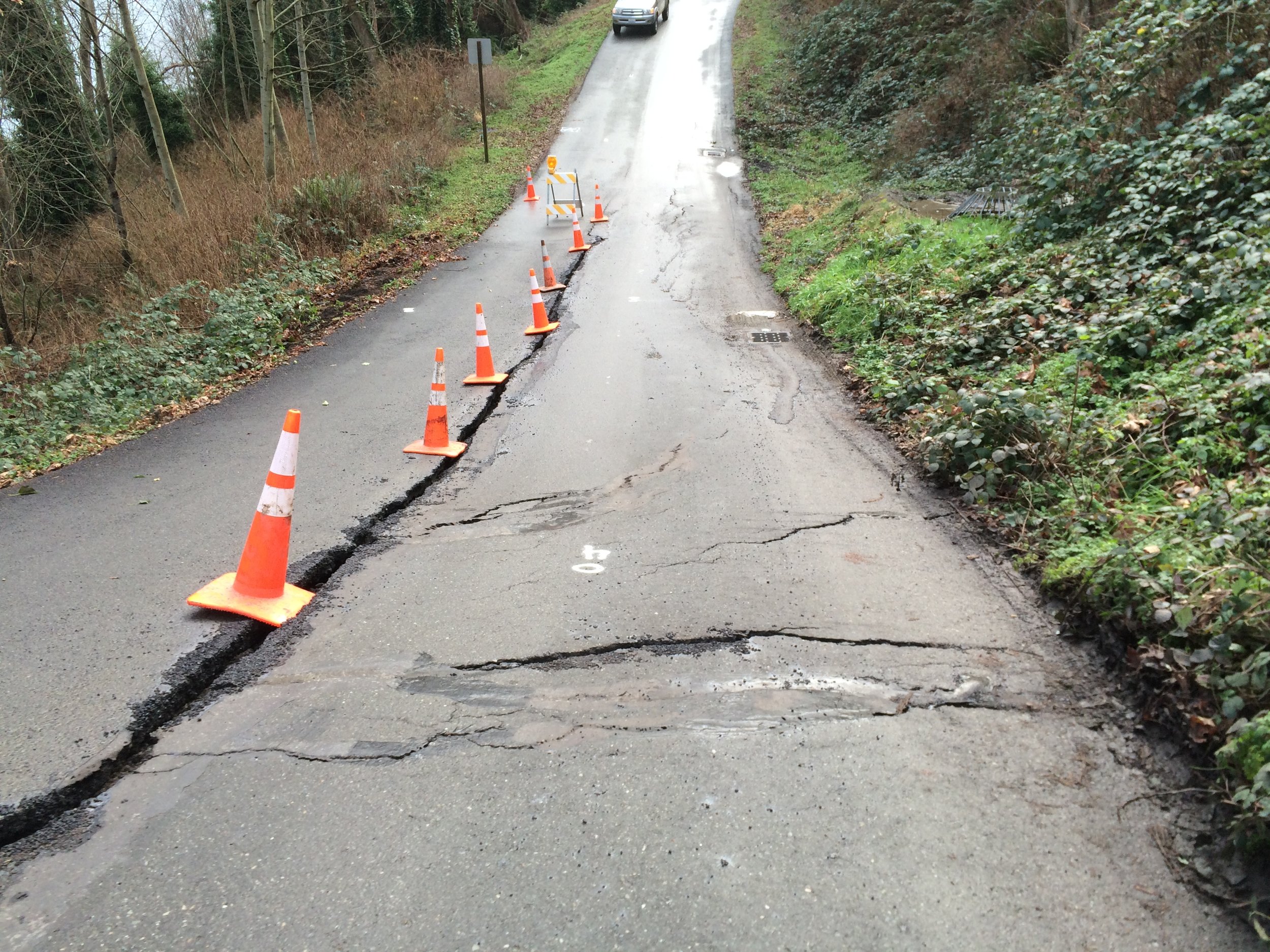The end of 2019 and the first months of 2020 brought unprecedented rainfall across the Pacific Northwest—as just two examples, January was the third wettest Seattle month ever; areas in Northeast Oregon received 10 inches of rain in 3 days. This even-rainier-than-usual season has inundated the region with flooding and landslides. These events are a threat to the safety of homes, businesses, and infrastructure. In this two-part series, we’re highlighting how Aspect professionals have been helping assess earth and water challenges caused by the rain and help communities and clients problem-solve.
Our first part of the series looks at some of the scientific tools we use to track hazardous conditions during wet weather and how we respond to help local communities assess and repair damage from earth movement.
Landslides: When Water and Steep Slopes Don’t Mix
Landslides lie dormant and unseen to the untrained eye for years, and even decades. However, intense short-term or persistent long-term rainfall can waterlog steep slopes and awaken landslides triggering widespread damage. In February 2020, following a period of heavy precipitation, a landslide six miles south of Bellingham shut down half of Washington State’s main business artery – Interstate 5 – for half a day.
Location of landslide across Interstate 5 south of Bellingham in February 2020
Photo Credit: Whatcom County Weather
One Tool to Understand Landslide Risk: Cumulative Precipitation Threshold
Among other monitoring approaches, Aspect’s geohazard team uses a public tool created by the United States Geological Survey (USGS) to help continuously assess the level of landslide risk in the Puget Sound region.
This tool was developed after reviewing data on historical conditions from 1933 through 1997, including several notable intense rain events that triggered multiple landslides in the Puget Sound area—notably those in 1986 and 1997, which are two of the biggest landslide “years” in Seattle history because of the amount of rainfall (and for 1997, the rain fell on top of snow during the winter, creating significant soil saturation conditions).
The tool uses monitoring points near Puget Sound coastal bluffs to give a snapshot of rainfall intensity and duration in the area. From these data, the USGS developed “rainfall thresholds” to forecast landslide potential and risk along rail corridors between SeaTac and Everett.
From this data, the USGS developed an intensity (I) and duration (D) relationship (shown above).
For example, on the left side, the graph shows that 1/10th (0.1) of an inch of rain per hour, falling steadily for about 22 hours, is enough to enter the high-risk threshold (yellow area over the blue line). Similarly, about 1/20th (0.05) of an inch per hour falling over 45 hours will enter the threshold. This means short-intense rain AND less intense, but long-duration rainfall can both oversaturate the ground and cause a landslide.
How Wet Has Winter 2020 Been in the Pacific Northwest?
Thanks to recent data from the USGS’ Mukilteo monitoring station, Winter 2020 in the Seattle area has been a season of unrelenting precipitation. We’ve had two different periods where the Seattle area has been over the cumulative landslide threshold for two straight weeks.
This is a snapshot of Jan 29, 2020, landslide threshold graph. Any symbols to the right of (or above) the red line indicates heightened landslide risk. Taking about a 2-month period, from Dec 1, 2019 – Feb 11, 2020, the Seattle area has been to the right of the line twice for significant, extended periods of time (for about two weeks straight each time—Dec 20, 2019, through about January 7, 2020, and from January 28, 2020, through Feb 11, 2020.) Special thanks to Rex Baum of the USGS for the recent Seattle-area 2020 data.
That is a substantial amount of time for soils to stay wet because, well, water is heavy. And when water saturates soil over longer-than-normal periods it adds enough weight that can cause the soil to move on steep slopes. Think about the difference between a box of feathers on a sloped bed of marbles versus a box of wet feathers on that same sloped bed of marbles. The heavier that box becomes it starts to move. Here are some additional technical factors involved in this kind of landslide:
A buildup of groundwater can pressurize the soil’s pore spaces, which reduces the strength of the soils causing the soils to fracture or slide.
Trees and their root structures can greatly reinforce shallow soils, but they have less ability to hold onto soils that have lost strength due to saturation, leading to loss of strength in the soil reinforced layer and toppling of shallow, rooted trees.
Responding to Geohazards
When active landslide hazard potential rises, Aspect’s geologists and geotechnical engineers prepare to support local agencies with whom we have on-call contracts. These contacts often include specific language that Aspect be ready to support public works staff as they respond to sudden or emergency geohazard events. During this last round of heavy precipitation, we were spurred to action with a call from the City of Kenmore—we provide geotechnical services as part of their team for an on-call contract—about a landslide impacting a roadway. We were on site to assess conditions within about one hour.
Result of a shallow surface landslide in Kenmore, which closed part of a road in the City.
Another view of the slide that resulted from heavy rains, which Aspect responded to within an hour.
The City wanted Aspect to assess potential risks. Are the residences atop the slope safe from further movement? How will removing the weight of the slide debris affect the slide? Our assessment concluded the slide posed a low risk to the residences and we were able to assure the City that removing the debris would not create further concerns for the slope.
Stay tuned for Part 2 of our Rainy Season series – where we learn how stormwater and water quality experts “storm chase” to track storms and perform water monitoring in wet conditions.












